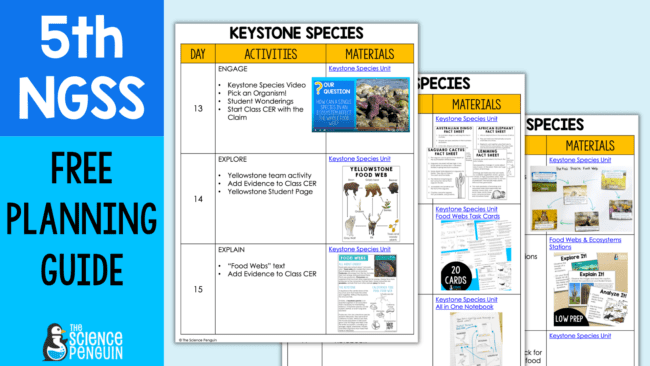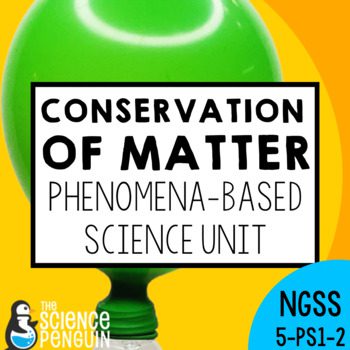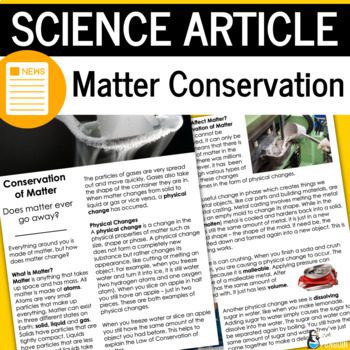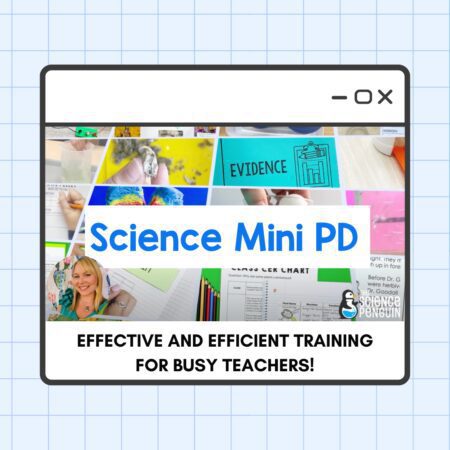My students are only allowed to drink water in our classroom. Over the years, I have had parents ask if they could have powdered flavors in their water, and at first, I was hesitant. But once I realized that I could use that powdered flavoring to teach a science concept like the conservation of matter, my answer was absolutely yes!
Grab your triple beam balance or food scale, and let’s get started!
Here’s how I use flavored water, as well as 7 other real-world examples, to teach the conservation of matter in physical and chemical changes in my classroom.
NGSS 5-PS1-2 has students measuring and graphing data to prove that mass does not change in physical and chemical reactions. Hands-on examples of reactions that our students see in real life are critical for understanding this concept.
Physical reactions are fairly easy to demonstrate with kids. At this grade level, I have to emphasize that any chemical reactions we will use in class will happen in a closed system, though that isn’t always our real-world experience.
1. Dissolving Drink Mix in Water🚰
Perhaps one of the most common reactions our kids see in real life! Students put a flavored drink mix into a water bottle and watch as the powder dissolves into the water. When possible, I try to find a drink mix without any coloring so students can actually see that the solution is still fairly clear. Since this is really about mass and weight, make sure students weigh the water bottle and powder before mixing and after.
2. Glow Sticks 💥
We love playing around with a glow stick, and it is the perfect closed system to model a chemical reaction. We weigh the glow stick before any reaction happens, and we weigh the glow stick after we snap and shake it.
3. Blowing Up a Balloon 🎈
While our students might not actually use this method to blow up balloons in real life, they have lots of real-world experience with balloons. This demonstration is always a fan favorite and the kids’ reaction to this reaction is priceless.
We find the mass of a water bottle with white vinegar and (separately) the mass of a balloon with baking soda in it. Once we place the balloon over the water bottle and allow the baking soda and vinegar to mix, we find the mass of the items again. Students are in awe when the mass remains the same!
4. Bananas in a Bag 🍌
A fairly simple experiment- if we slice a banana, seal it in a baggie, and let it sit for a week as it decomposes, will its weight change? This one is a great conversation starter because, if we were to open the baggie and weigh it again, the weight would change slightly. What is happening chemically that makes this occur?
5. Melting Chocolate 🍫
Another simple experiment! As we heat up chocolate and it melts, will the mass of the chocolate change?
6. Melting Ice 🧊
Same principle! Will solid ice and water have the same mass?
Ready-to-Use Resource
Investigations 1-6 can be found in Conservation of Matter Phenomena-Based Science, where we’ve put together everything you need for this standard in one place. New to teaching NGSS with phenomena?
7. Mixing Coins 💰
Math and science in one! If I have a quarter, three dimes, and six pennies, how much money do I have? How much do the coins weigh? What if I weigh the three types of coins separately- will they still weigh the same amount when their weights are added together?
8. More Water Investigations 🏝
This investigation comes from our Beaches Phenomenon unit. What happens when we mix salt with water, and then sand with water? This particular experience has a lot of great learning for students. Not only does this cover the conservation of matter standard, but students can also easily comprehend (and visualize) the difference between a solution and a mixture.
See our Beaches Phenomenon-Based Unit. The unit includes lab sheets, teacher instructions, lesson plans, a quiz, and more!
I hope your students love learning about physical changes, chemical changes, and the Law of Conservation of Matter with these fun and engaging labs. Make your planning and prep easy with our resources below!
-Mikey, 5th Grade Teacher and Science Penguin Blogger
Top Conservation of Matter Resources
For the conservation of matter during physical and chemical changes, use the Conservation of Matter Unit.
For the conservation of matter during the creation of a solution, use the Beaches Unit.
Add to your lessons by using the Matter Conservation Article with questions worksheet and the Changes of Matter Task Cards.
Sign up for your free 5th grade NGSS guide!

Sign up with your personal email and check your email for immediate access to a full year of science planning ideas for 5th grade NGSS.









